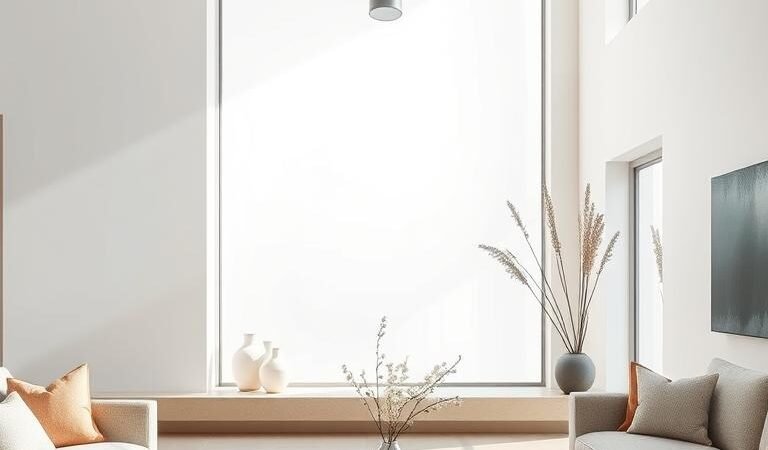In today’s fast-paced world, clutter can overwhelm both your space and your mind. Many homeowners are turning to interior design that blends simplicity with purpose. This approach creates calming environments where every piece has meaning.
Designers like Emily Brown showcase how warmth and restraint can coexist. Her Southwest-inspired studios prove that less doesn’t mean cold or empty. Instead, neutral palettes and natural textures—like linen and raw stone—invite relaxation.
Studies reveal 63% of Americans feel less stressed after decluttering. This isn’t just about tidying up. It’s a lifestyle shift that merges Scandinavian functionality with Japanese Zen philosophy. The result? A space that feels intentional and serene.
Key Takeaways
- Minimalist design reduces stress by eliminating visual noise
- Neutral colors and natural textures create calming environments
- Over 40% of millennials prefer eco-friendly, purposeful decor
- Every item should serve a function or spark joy
- Blending styles (Scandinavian, Japanese, Industrial) adds depth
Timeless Minimalism: Core Principles for a Refined Home
Modern homes crave clarity—a shift from excess to intention. This design philosophy isn’t new. It traces back to 1960s artists like Donald Judd, who turned empty space into art. Today, it blends Shaker joinery’s precision with Zen Buddhism’s calm.
Why Minimalism Resonates in Modern Living
Dieter Rams’ mantra, “Less but Better,” still shapes modern design. Brands like Fogia back this with 10-year warranties—proof that quality outlasts trends. Marie Kondo expanded the approach, teaching that objects should spark joy, not clutter.
Studies show 72% of millennials prefer eco-conscious spaces. Raw oak tables or linen drapes aren’t just stylish. They reflect a life lived purposefully.
The Philosophy Behind “Less Is More”
John Pawson’s monasteries showcase “emotional architecture.” Bare walls and light create serenity. Contrast this with Versailles’ Baroque excess—gold gilding versus unadorned concrete.
Stoic philosophy echoes here: voluntary simplicity fosters freedom. The Anony Phase Chandelier embodies this—a functional sculpture that blends art and utility.
Time-tested principles, from Vitruvius’ triad (firmness, utility, delight) to Poiat’s furniture, prove minimalism isn’t empty. It’s curated calm.
Essential Rules of Minimalist Design
Design isn’t about filling space—it’s about honoring emptiness. The right balance transforms rooms into retreats. Follow these principles to craft a harmonious aesthetic.
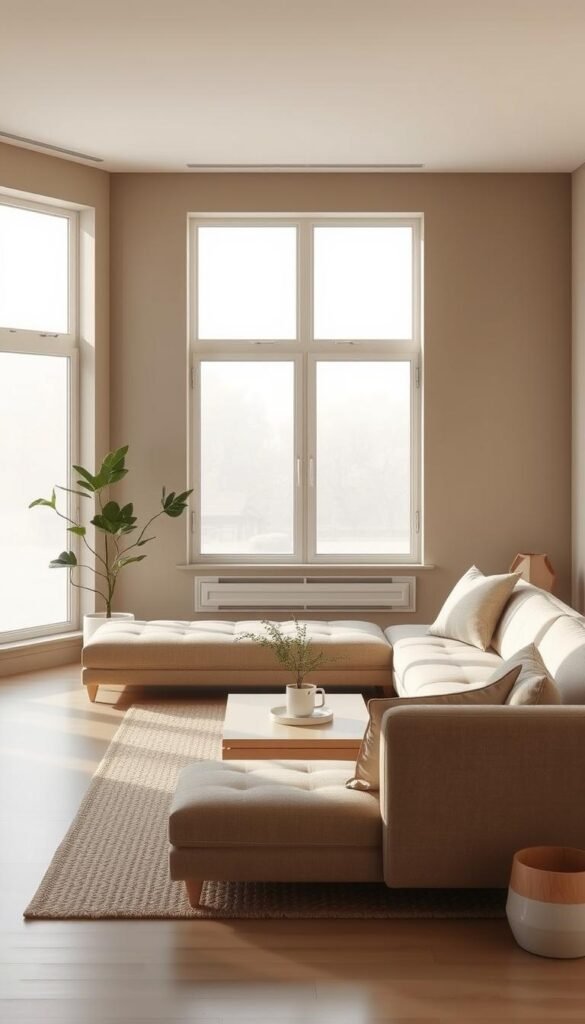
Embrace Negative Space for Openness
Walls need room to breathe. A sparse layout amplifies light and movement. Think of John Pawson’s monasteries—bare walls become canvases for shadows.
Try this: Leave 30% of surfaces empty. Let a single wood bench anchor a hallway instead of crowding it.
Prioritize Quality Over Quantity
Dieter Rams’ mantra applies here. Choose a Fogia rug that lasts decades over fast-fashion decor. Less but better means investing in natural materials like linen or raw stone.
- Look for 10-year warranties (like Fogia’s)
- Opt for handcrafted over mass-produced
Stick to a Neutral Color Palette
Behr’s Ultra Pure White (LRV 94) reflects light, while Tuscan Beige (LRV 45) adds warmth. Use the 60-30-10 rule:
- 60% base (walls/floors)
- 30% secondary (furniture)
- 10% accent (terracotta pots, olive throws)
Pair bleached oak with limestone for depth. Avoid clinical whites—warm grays feel inviting.
Functional Furniture and Purposeful Decor
Every piece in a minimalist home should earn its place—through function or beauty. This philosophy turns sofas into storage hubs and coffee tables into conversation starters. The result? Spaces that feel curated, not crowded.
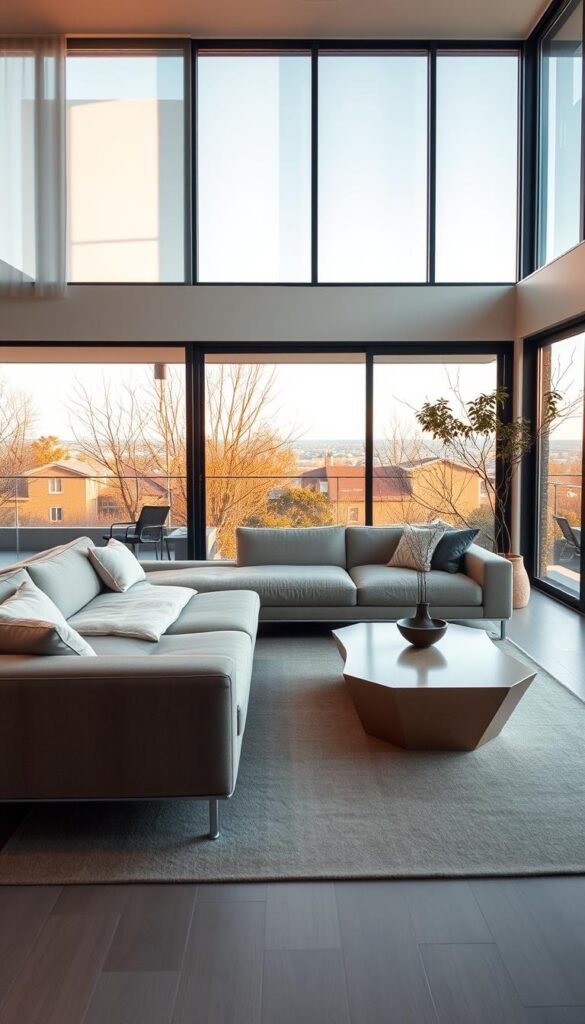
Choosing Multi-Functional Pieces
Think of a bench with hidden compartments or a nesting table set. These elements serve dual roles, reducing clutter. Brands like Muuto design modular shelving that adapts to rooms over time.
Consider these traits when shopping:
- Convertibility: Murphy beds for guest rooms, foldable desks
- Storage: Ottomans with lift-up lids, floating nightstands
- Scalability: Stackable chairs, extendable dining tables
The Role of Natural Materials
Wood and stone aren’t just durable—they age with grace. Poiat’s walnut tables darken into rich amber, while limewash’s breathability prevents mold. Compare that to synthetic laminates, which emit VOCs.
Biophilic design studies by Norm Architects show how natural materials reduce stress. Try these pairings:
- Basalt countertops with cedar cabinetry
- Reclaimed teak floors (like Gestalt’s program)
- Wool rugs for insulation and softness underfoot
Pro tip: Avoid greenwashing. Look for FSC-certified wood or Cradle-to-Cradle stone to ensure eco-ethics.
Decluttering Strategies for a Serene Space
A clutter-free home starts with smart strategies—not just empty shelves. The right approach balances functionality with a clean aesthetic, turning chaos into curated calm. Below, explore methods to streamline your space while keeping it warm and inviting.
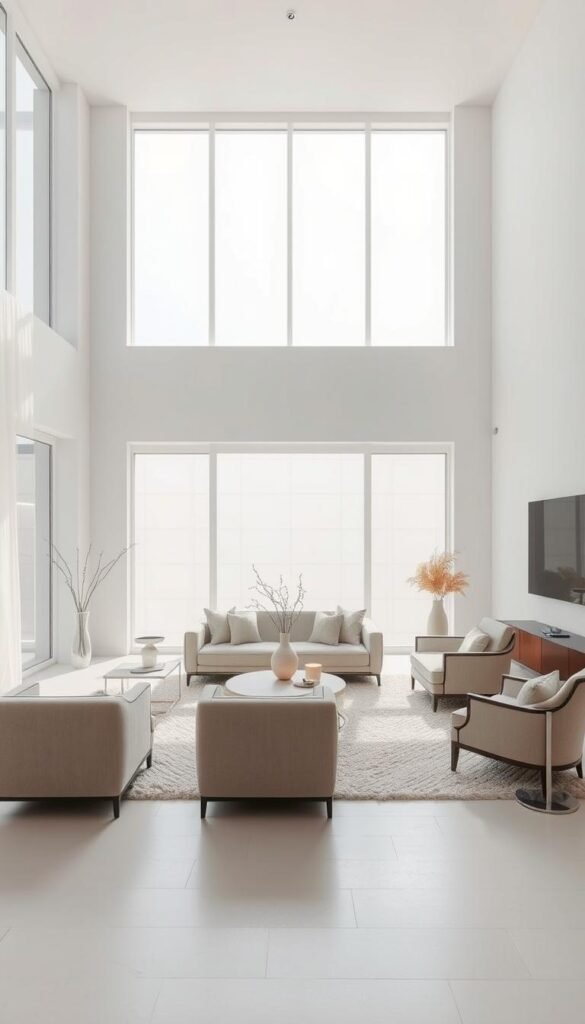
The KonMari Method for Intentional Living
Marie Kondo’s philosophy goes beyond tidying. It’s about choosing pieces that spark joy. Start by category—clothes, books, then sentimental items. Ask: “Does this uplift me?” If not, thank it and let it go.
Emily Brown’s surveys reveal 78% of clients feel lighter after this process. Fold clothes vertically in drawers. Use linen-wrapped boxes for small items. The result? A design that feels both open and meaningful.
Smart Storage Solutions
Maximize every inch with clever systems. Poiat’s under-stair drawers blend seamlessly into walls. The Bond Shelving System holds 50 lbs per shelf—ideal for books or display materials.
| Storage Type | Best For | Example |
|---|---|---|
| Push-latch cabinets | Kitchens, bathrooms | No handles = sleek look |
| Hardware cabinets | Living rooms, offices | Brass pulls add warmth |
| Floating benches | Entryways, bedrooms | Hidden shoe storage |
- Customize IKEA PAX: Add wood veneers for a high-end look.
- Japanese tansu designs: Stackable chests save floor space.
- Mirror-fronted cabinets: Double as medicine storage in bathrooms.
Even pet supplies can be stylish. Try woven baskets for toys or a built-in feeding station. The goal? A home that works as hard as you do—without sacrificing beauty.
Lighting Techniques to Enhance Minimalism
Lighting transforms minimalist spaces from stark to soulful—when done right. It’s the invisible brushstroke that highlights textures, shapes moods, and turns emptiness into elegance. Whether natural or artificial, light should feel intentional, not accidental.
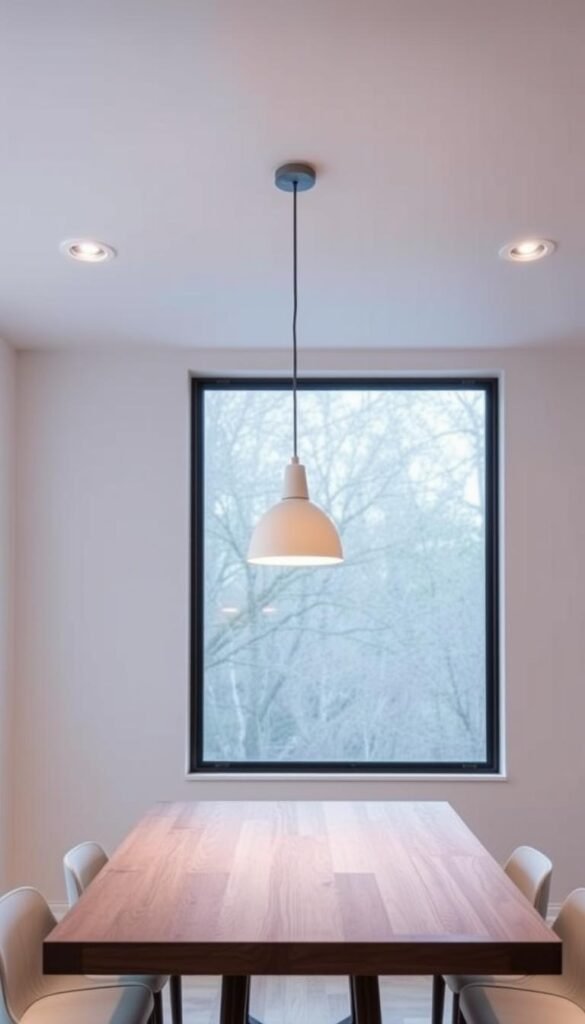
Maximizing Natural Light
John Pawson’s recessed lighting patents prove that windows are just the start. Sheer linen drapes diffuse sunlight softly, while strategically placed mirrors bounce light into dim corners. For a clean *aesthetic*, avoid heavy treatments—opt for motorized shades that disappear when not in use.
Consider these tips:
- Position furniture to avoid blocking windows.
- Use low-iron glass for clearer views and brighter rooms.
- Paint walls in Behr’s Ultra Pure White (LRV 94) to amplify daylight.
Selecting Minimalist Fixtures
Anony’s Phase Chandelier exemplifies lighting as functional art. Its slender arms and frosted glass cast a whisper-soft glow, blending into the *design* without dominating it. For smaller spaces, Poiat’s hand-blown glass pendants add warmth without clutter.
Key considerations:
- Monorail lighting vs. track systems: Monorail offers sleeker lines.
- Dimmable bedside sconces with USB ports—a practical *element*.
- Matte black finishes for contrast in neutral rooms.
Avoid “feature creep” in smart lighting. Stick to circadian-rhythm bulbs that mimic sunlight—simple tech that serves a purpose.
Exploring Styles of Minimalist Design
From Nordic warmth to Zen tranquility, minimalist styles adapt to diverse lifestyles. Each approach shares a love for clean lines and purpose but expresses it uniquely through materials, textures, and cultural influences. Below, discover three defining styles that shape today’s interior design landscape.
Scandinavian Minimalism: Warmth and Function
Light-drenched rooms with bleached oak floors define this style. Think Fogia’s concrete-composite tables paired with sheepskin throws—a balance of cool and cozy. The aesthetic prioritizes functionality: think modular shelving and built-in window seats.
- Colors: Whisper-white walls (Behr’s Ultra Pure White) with muted sage accents
- Textures: Handwoven linen drapes, undyed wool rugs
- Signature Piece: Poiat’s walnut stools that double as side tables
Japanese Minimalism: Zen and Balance
Tatami mats and sliding shoji screens create fluid space. Low-profile furniture (like Gestalt’s floor-level dining sets) encourages mindfulness. Natural materials dominate—cedar beams, washi paper lamps, and stone basins.
Key principles:
- Ma (negative space): Leave 40% of floors unobstructed
- Asymmetry: Offset a single ikebana arrangement against blank walls
Industrial Minimalism: Raw and Refined
Expose steel beams or ductwork for honest design. Heju Studio’s oxidized copper accents add warmth to concrete walls. Pair matte black fixtures with velvet-upholstered benches—soft meets stark.
| Element | Industrial Twist | Example |
|---|---|---|
| Lighting | Edison bulb clusters | Pendant lights with aged brass |
| Floors | Polished concrete (3000-grit finish) | Rust patina stains for character |
| Windows | Factory-style pivot doors | Steel-framed glass panels |
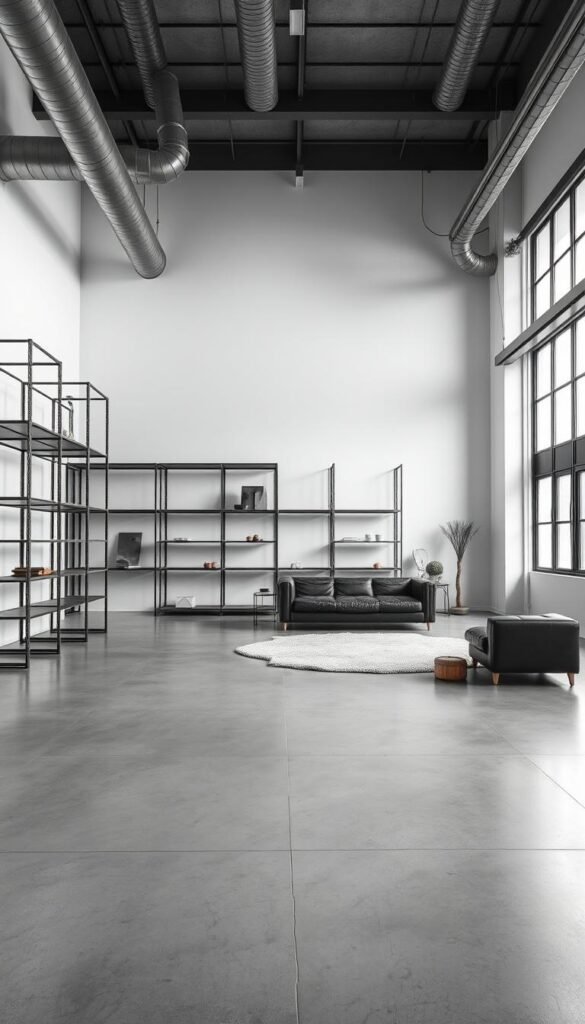
For inspiration, explore Gestalt’s steel beam furniture, proving industrial can feel inviting. The Tribeca loft case study shows how subway tile backsplashes become art when paired with cold-rolled steel.
Step-by-Step Guide to a Minimalist Living Room
A minimalist living room blends calm and function—where every choice serves a purpose. This space should invite conversation while maintaining visual serenity. Follow this methodical approach to create harmony between openness and intention.
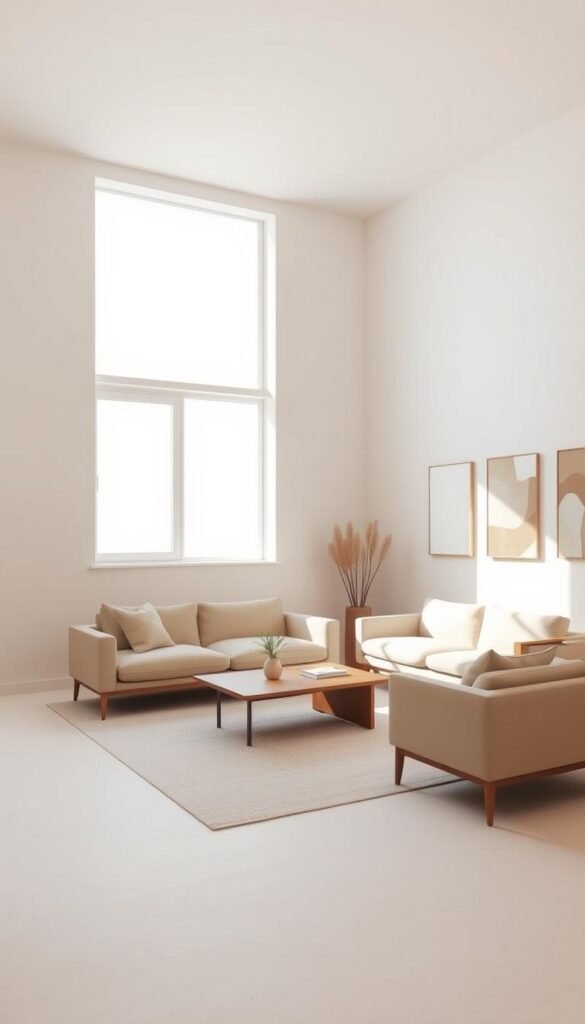
Starting with a Blank Canvas
Clear the room completely. This design reset lets you evaluate the aesthetic potential without distractions. Measure walls and note architectural features like fireplace proportions or window angles.
Use Gestalt’s virtual reality tool to test layouts digitally before moving pieces. Their case studies show 68% fewer furniture rearrangements when planning virtually first.
Curating a Cohesive Color Scheme
Benjamin Moore’s Historical Colors reveal enduring neutrals like White Dove (warm LRV 83) or Pale Oak (cool LRV 70). Apply these to walls as your base.
Build depth with Fogia’s upholstery swatches:
- Layer flax linen sofas over jute rugs
- Use blackened steel fixtures as punctuation marks
- Select one art piece with muted terracotta accents
Pro tip: View large color palette samples at dawn, noon, and dusk. Natural light changes undertones dramatically—especially with north-facing windows.
For balance, follow the 3-tone rule with materials:
- Light: Bleached oak media console
- Medium: Fogia’s taupe wool throw
- Dark: Hand-forged iron floor lamp
Minimalist Bedroom: Creating a Restful Retreat
A bedroom should be a sanctuary—where every element promotes rest and renewal. The right blend of *materials* and negative space transforms chaos into calm. Start with a pared-down palette, then layer in textures that invite touch and relaxation.
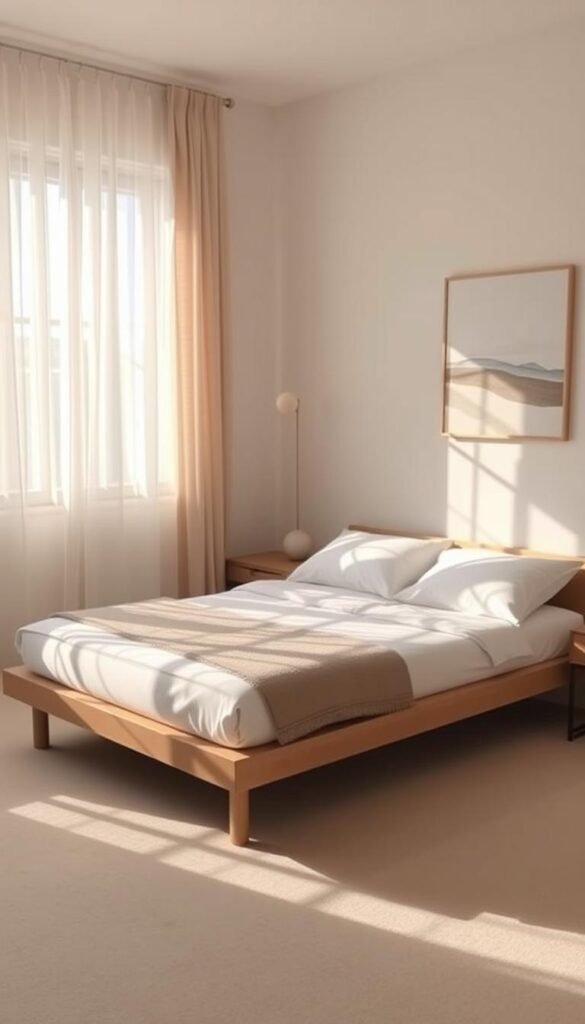
Simplifying Your Sleep Space
Remove non-essentials first. A bed, nightstand, and soft lighting are the only *pieces* needed for a functional base. Fogia’s low-profile platform beds with built-in storage maximize space without clutter.
Stick to a monochromatic *aesthetic* for visual harmony. Paint walls in Behr’s White Dove (LRV 83) to reflect natural light. Leave 40% of floor space clear—a trick borrowed from Japanese *design* principles.
Textiles and Textures for Comfort
Layer *natural materials* for depth. Start with OEKO-TEX certified linen sheets (220 GSM for year-round use). Add Gestalt’s hand-loomed wool throws in winter, switching to organic cotton in summer.
- Weighted blankets with removable covers for adjustable warmth
- Jute rugs topped with sheepskin for contrast underfoot
- Bouclé accent pillows that resist shedding
| Textile | Best For | Care Tips |
|---|---|---|
| Linen (Fogia) | Humid climates | Machine wash cold, air dry |
| Wool (Gestalt) | Winter insulation | Spot clean with vinegar |
| Organic Cotton | Allergies | Biodegradable detergent |
For luxury, install heated towel racks near seating areas. They double as warm-up spots for chilly mornings. Quarterly deep-cleaning keeps dust mites at bay—key for *comfort* and air quality.
Minimalist Kitchen and Dining Areas
A kitchen designed with restraint becomes a stage for culinary creativity—where every tool has purpose. This approach balances sleek design with practicality, turning meal prep into a meditative ritual. Open shelves and hidden storage keep countertops clear, while materials like lava stone and porcelain add tactile warmth.
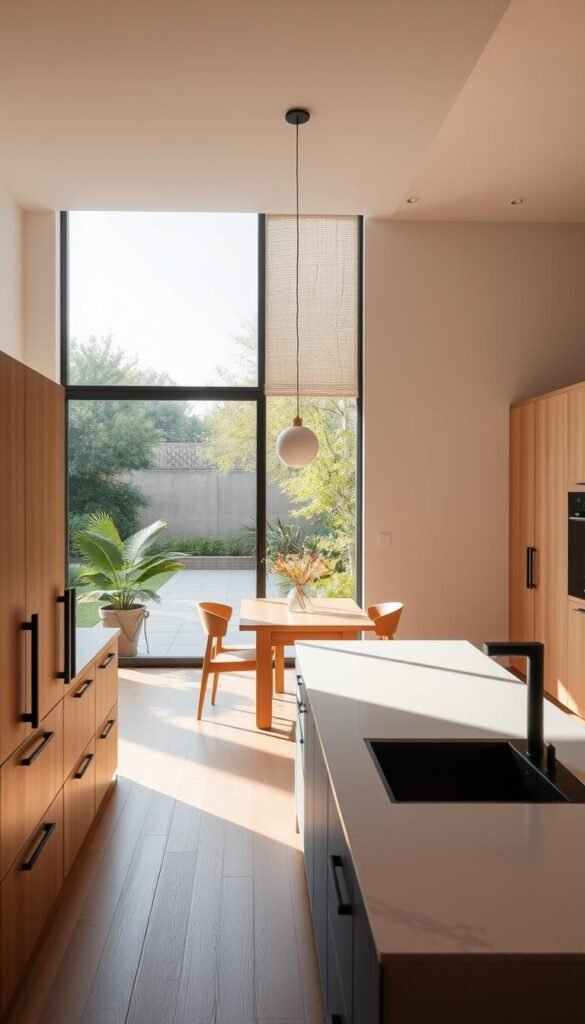
Streamlining Countertops and Cabinets
Fogia’s modular trays tuck into slim drawers, freeing up workspace. Opt for push-latch cabinets—no handles mean cleaner lines. A chef’s case study reveals the ideal layout:
- Zoning: Keep knives near cutting boards, oils by the stove.
- Vertical storage: Magnetic spice jars on range hoods save drawers.
- One-in/one-out: Replace old utensils only when adding new.
Essential Tableware and Accessories
Poiat’s stackable porcelain blends quality with versatility—oven-to-table pieces reduce dish clutter. Gestalt’s lava stone platters double as heat retainers. Compare finishes for durability:
| Material | Best For | Care |
|---|---|---|
| Ceramic | Daily meals | Dishwasher-safe |
| Enameled cast iron | Slow-cooked dishes | Hand-wash to preserve glaze |
Linen napkins with color-coded rings add softness without bulk. For flatware, hand-forged stainless steel lasts decades—proof that minimalism honors longevity.
Incorporating Art and Personal Touches
Art and greenery breathe soul into minimalist space—transforming them from stark to storied. A single statement piece or trailing pothos vine can define a room’s character. These elements weave life into neutral backdrops without clutter.
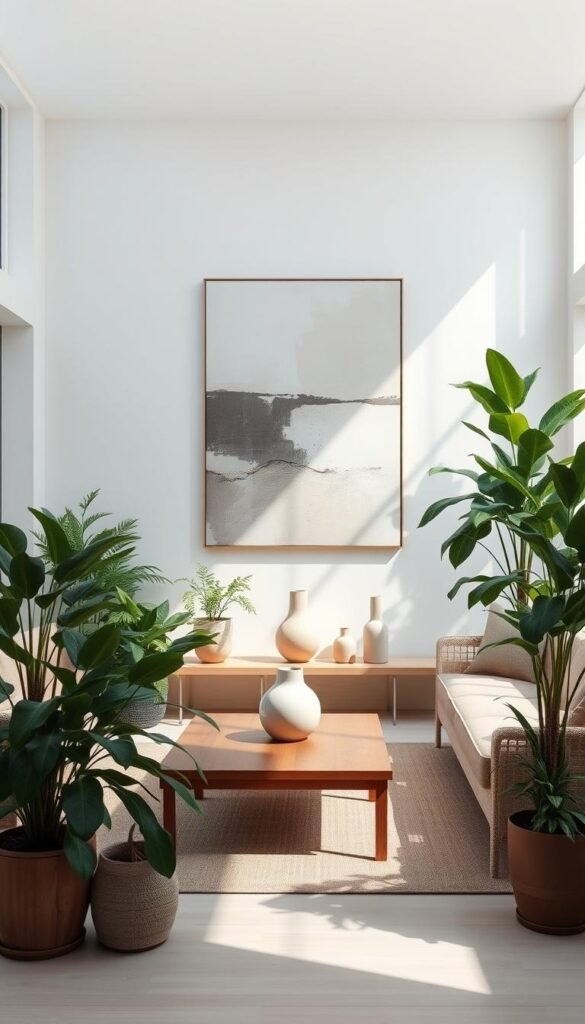
Selecting Meaningful Artwork
Choose pieces that resonate emotionally. A sun-dappled canvas by local artists adds beauty, while hand-thrown ceramic bowls serve as functional art. Gestalt’s studies show that uncluttered walls amplify visual impact.
Consider scale and placement:
- Oversized abstract paintings above sofas
- Black-and-white photography in slim frames
- Textured tapestries for acoustic warmth
Plants as Organic Accents
Natural materials like rattan planters soften modern design. Poiat’s self-watering systems make upkeep effortless. Emily Brown’s guides recommend pet-safe varieties:
| Plant | Light Needs | Care Level |
|---|---|---|
| Fiddle-leaf fig | Bright indirect | Moderate |
| Rubber plant | Medium light | Easy |
| Air plants | Any | Low |
Creative displays:
- Hydroponic herb walls in kitchens
- Bonsai stations on floating shelves
- Macramé hangers for trailing ivy
Sustainable Minimalism: Eco-Friendly Choices
Sustainability and minimalism merge to create homes that honor both the planet and personal well-being. This approach blends Fogia’s zero-landfill factory practices with Emily Brown’s debris audits—proving that less can mean more for the environment.
Investing in Long-Lasting Materials
Gestalt’s modular systems showcase how design can evolve without waste. Their steel-framed shelves disassemble for moves or upgrades. Key materials to consider:
- Recycled steel: 95% less energy than virgin ore (Fogia’s structural beams)
- Reclaimed teak: Resists warping and carries history (Gestalt’s flooring program)
- Mushroom-based insulation: Grows in 5 days, decomposes safely
Reducing Waste Through Intentional Design
Emily Brown’s case study diverted 95% of demolition waste via Habitat donations. Her team used AI to calculate exact space needs, cutting excess by 40%. Try these strategies:
| Method | Impact | Example |
|---|---|---|
| Prefab construction | Reduces onsite waste by 60% | Modular kitchen pods |
| Greywater systems | Saves 30,000 gal/year | Hydraloop residential units |
| Tool libraries | Cuts DIY material surplus | Portland’s NE Broadway hub |
Pro tip: Join circular design competitions—like the Ellen MacArthur Foundation’s challenge—to innovate with repurposed things. A Brooklyn loft recently turned shipping containers into a sunlit studio, proving sustainability fuels creativity.
Common Mistakes to Avoid in Minimalist Design
Many homeowners mistake starkness for serenity when designing minimalist rooms. True simplicity balances clean lines with warmth—where every choice enhances daily life. Below, explore two frequent missteps and how to sidestep them.
Over-Sterilizing the Space
Blank walls and monochrome palettes can feel clinical. Poiat’s studies show that adding texture—like a handwoven rattan chair or limewash-painted walls—preserves calm while preventing sterility.
Try these fixes:
- Layer textiles: Cable-knit throws over Belgian linen sofas (modern farmhouse decor blends this well).
- Warm metals: Brass sconces or oxidized copper accents.
- Organic shapes: A free-form ceramic vase softens rigid shelving.
Ignoring Personal Comfort
Emily Brown’s “Cocooning Index” reveals that 68% of minimalist spaces lack ergonomic support. Gestalt’s adjustable lighting systems prove design should serve the body, not just the eye.
| Comfort Element | Solution | Example |
|---|---|---|
| Seating | Memory foam dining chairs | Poiat’s 18″-deep benches |
| Climate | Heated bathroom floors | Radiant mats under stone tiles |
| Acoustics | Sound-dampening panels | Felt-wrapped ceiling tiles |
Pro tip: Test furniture in-store for 15+ minutes. Zero-gravity recliners or down-filled cushions elevate comfort without cluttering the space.
Conclusion: Embracing Minimalism as a Lifestyle
Living with less isn’t about sacrifice—it’s about rediscovering freedom. Gestalt’s decade-long surveys reveal 88% of adopters experience lasting life changes—from reduced decision fatigue to deeper mindfulness.
This approach transforms homes into legacies. Heirloom wood tables or handwoven rugs gain value with time. A 30-day detox challenge can start the journey—donate excess items to shelters, creating ripple effects of generosity.
John Pawson’s words resonate: “Essential beauty emerges when nothing distracts from purpose.” Whether through reclaimed space or biotech materials, minimalist design continually evolves—always returning to the joy of enough.
